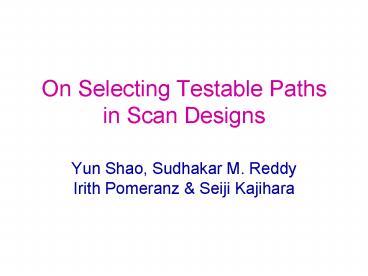On Selecting Testable Paths in Scan Designs - PowerPoint PPT Presentation
1 / 17
Title:
On Selecting Testable Paths in Scan Designs
Description:
Address combinatorial complexity and fault coverage issues of path delay fault model ... Use the delay of the longest potentially testable path ever found as a ... – PowerPoint PPT presentation
Number of Views:60
Avg rating:3.0/5.0
Title: On Selecting Testable Paths in Scan Designs
1
On Selecting Testable Paths in Scan Designs
- Yun Shao, Sudhakar M. Reddy Irith Pomeranz
Seiji Kajihara
2
Motivation
- Tests for small delay defects
- Address combinatorial complexity and fault
coverage issues of path delay fault model
3
Approach
- Minimal Testable Path Cover of the CUT
- Select a minimal size set of testable path S,
such that for each circuit lead l, S contains at
least one testable path of maximum delay through
l.
4
Minimal Path Covers Earlier Works
- Select at least one longest structural path
passing through each line - An exact polynomial time algorithm to find a
minimum structural cover set Li et al.,
TCAD89. - Drawback - Many paths in the structural cover set
are untestable because of the lack of
consideration of the testability of selected
paths.
5
Minimal Path Covers Earlier Works (cont)
- Enumerate a limited number of longest paths
through every line to find a testable path cover
set - Enumerate N paths passing through each line until
a robustly testable path is found Majihi et al.,
VLSI96 - Select potentially testable paths to cover all
lines Cheng et al., TCAD96, Murakami et al.,
ITC00 - Drawback A large number of paths are explicitly
enumerated during path selection and the run time
is high.
6
Untestable Path Identification
- Non-enumerative untestable path identification
Kajihara et. al. VLSI 97 - Every path passing through both a b-line (back
line) and a f-line (front line) is
unsensitizable. - The b-line and f-line describing untestable paths
are referred to as a b-f pair
Outputs
Inputs
f-line
b-line
b-f pair
7
Terminology
- Two definitions Park et al. TCAD92
- The Longest Structural Path Delay the maximum
delay of all structural paths passing through a
line (without considering the testability of
paths) - The Longest Functional Path Delay the maximum
delay of all testable paths passing through a
line - Structural (Functional) Covered - a line covered
by a structural (testable) path with its longest
structural (functional) path delay.
8
Contributions
- Use delay analysis to estimate the longest
functional path delay of each line - Expand a potentially testable path (containing no
b-f pair) to cover a given line - Use a branch-and-bound strategy to iteratively
search for a longest potentially testable path
through a target line
9
Delay Analysis
- We propose an efficient procedure to compute an
upper bound of the longest functional path delay
of a line. It includes two passes. - Estimate the longest functional path delay
LDPI(l) (LDPO(l)) from the inputs (outputs) to
every line l - For a given f-line (b-line), all paths passing
through its b-lines (f-lines) are excluded when
computing the longest functional path delay from
the inputs (outputs) to the line.
10
Stepwise Path Expansion
- Objective
- Construct a potentially testable path passing
through the target line with maximum delay - Proposed method
- Forward (Backward) Expansion - expanding the
target line toward the outputs (inputs) without
including b-f pairs. - Greedy approach In every forward (backward)
expansion step an expansion line with the
greatest LDPO (LDPI) is chosen to expand the
partial path already constructed. - Cant guarantee to get a global longest
potentially testable path in one iteration.
11
Stepwise Path Expansion (cont)
- Heuristic 1 Minimum Cover Expansion
- Choose the local expansion that can cover the
maximum number of yet uncovered lines. - Heuristic 2 Delay Constrained Expansion
- Search for potentially testable paths with delays
greater than a specified value Dmin - Use the delay of the longest potentially testable
path ever found as a threshold to iteratively
reduce the search space by looking for paths with
delay greater than the longest path obtained.
12
Stepwise Path Expansion (cont)
b-line
Inputs
f-line
Outputs
f-line
b-line
FFR
backward expansion line
l
forward expansion line
initial PPI
Decision point
- Mark the b-lines and f-lines of the lines
included in the partial path. - Select unmarked lines to expand the partial path.
- Backtracking is required when the partial path
cant be expanded further without including a b-f
pair.
13
Overall Flow
- ATPG is used to check if the selected potentially
testable path is truly testable.
min_delay 0
Fail
min_cover_expand(l, min_delay)
A
succeed
succeed
untestable
ATPG(p)
next_path(min_delay)
detected
Fail
true
D(p) DP(l)?
B
A
false
min_delay D(p) incr_delay
14
Experimental Results (cont)
- Comparing line coverages (with respect to
coverable lines) for scan designs using
functional justification (weak non-robust)
15
Experimental Results (cont)
- Comparing line coverages (with respect to all
lines) of weak non-robust tests and strong
non-robust tests for scan designs using
Functional Justification
16
Experimental Results
- Cover sets for Scan Designs using Functional
Justification (weak non-robust)
17
Conclusions
- Proposed an efficient method to select paths to
test. The selected set of paths have minimal
size, are testable and include each circuit line
in at least one path of maximum delay containing
the line. - The run time for the entire procedures including
test generation time is comparable to that for
generating tests for the set of selected paths.































